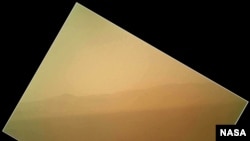The mood at NASA's Jet Propulsion Laboratory mission control center in California quickly changed from anxiety to exhilaration, with cheers erupting, as soon as engineers confirmed that the Curiosity rover made a perfect landing on Mars August 6, after a nearly 9-month voyage from Earth.
Mars Science Lab team members were jubilant as they learned the rover's parachute had deployed, its rocket thrusters had ignited, and its skycrane had activated for a flawless touchdown.
Within minutes, Curiosity provided its first black and white image from Mars. The rover sent an image of its wheel, proof of a solid landing.
At a news briefing Monday afternoon, NASA showed more images from Curiosity's first few hours on its new home planet.
One showed a windswept Martian plain. Scientists say another shows what might be an outline of Mount Sharp, the peak in Gale Crater that is expected to yield information about the planet's evolution.
NASA video of Curiosity landing process
Mission Manager Michael Watkins said colorful panoramic and three-dimensional images will come. "But these first images are always somehow the best to me because when you land on Mars, it's new every time," said Watkins. "This is a new place on Mars. We go on vacation to see a different part of the Earth. It's on our own planet, and here we're seeing a part of Mars we've never seen before."
But Curiosity was not only a photographer. It also was photographed.
From a distance of about 340 kilometers, NASA's Mars Reconnaissance Orbiter took a picture of the Mars Science Lab - its parachute deployed after its fiery descent through the Martian atmosphere.
The detailed image thrilled those in the Jet Propulsion Laboratory briefing room.
And everything seemed to thrill everyone at the post-landing news conference.
John Grunsfeld, a NASA scientist and former astronaut, said, "There are many out in the community who say that NASA has lost its way, that we don't know how to explore, that we've lost our moxie. I think it's fair to say that NASA knows how to explore. We've been exploring. And we're on Mars."
NASA Administrator Charles Bolden looked to the future. "Today, right now, the wheels of Curiosity have begun to blaze the trail for human footprints on Mars," Bolden said.
The nuclear-powered mobile laboratory has a two-year mission to explore the Red Planet.
Bolden said the rover "will seek to answer age-old questions about whether life ever existed there on Mars or if the planet can sustain life in the future."
NASA officials say initial tests show the rover's 10 science instruments survived the long journey. In the coming days, checkout procedures will continue, and the rover will send additional images. And before long, Curiosity's science mission will begin.







